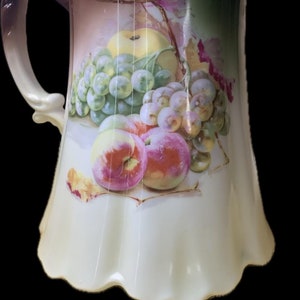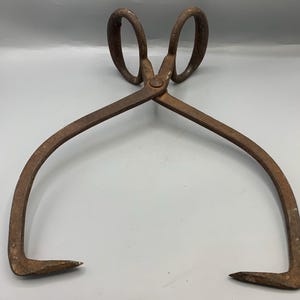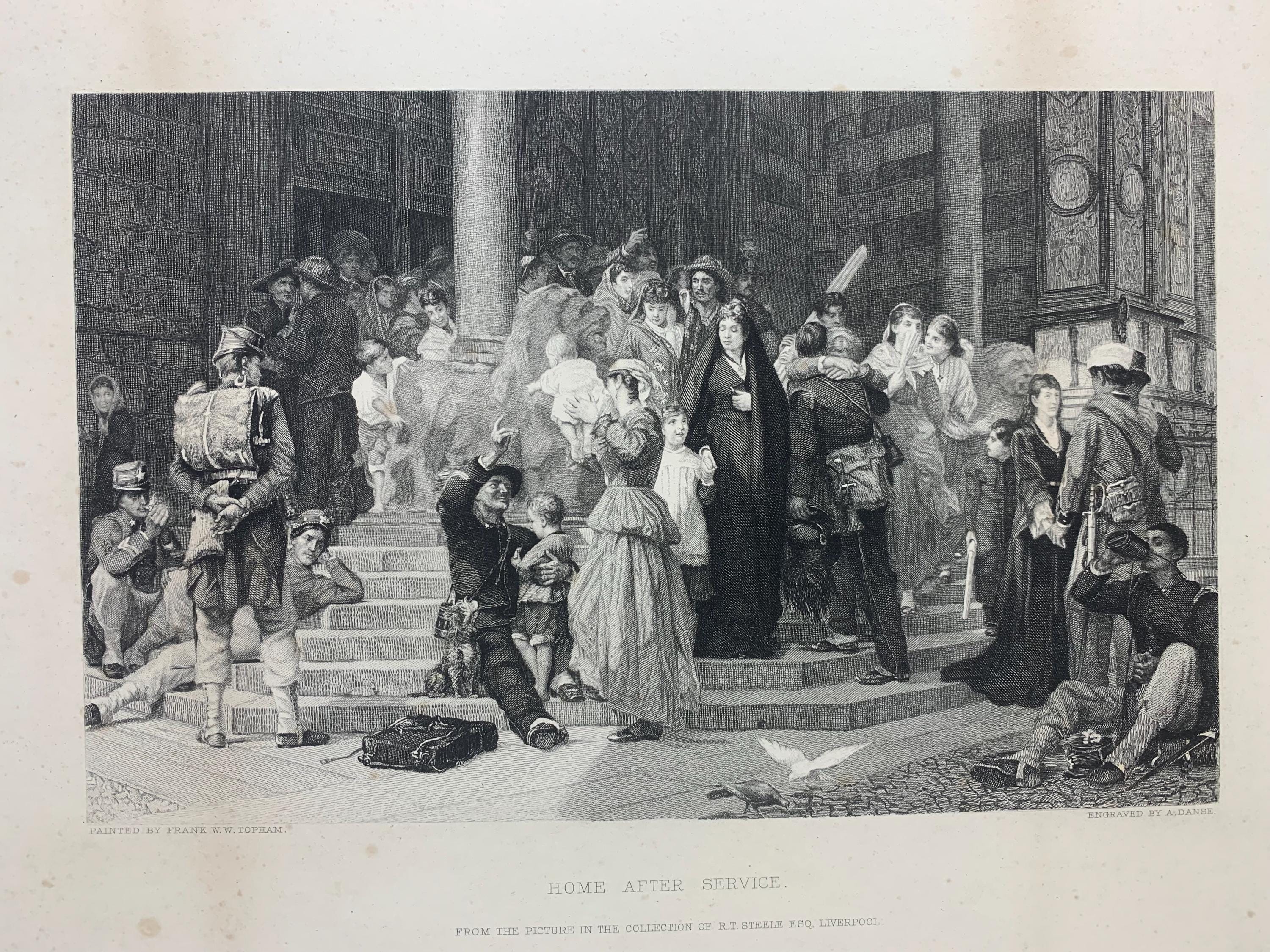
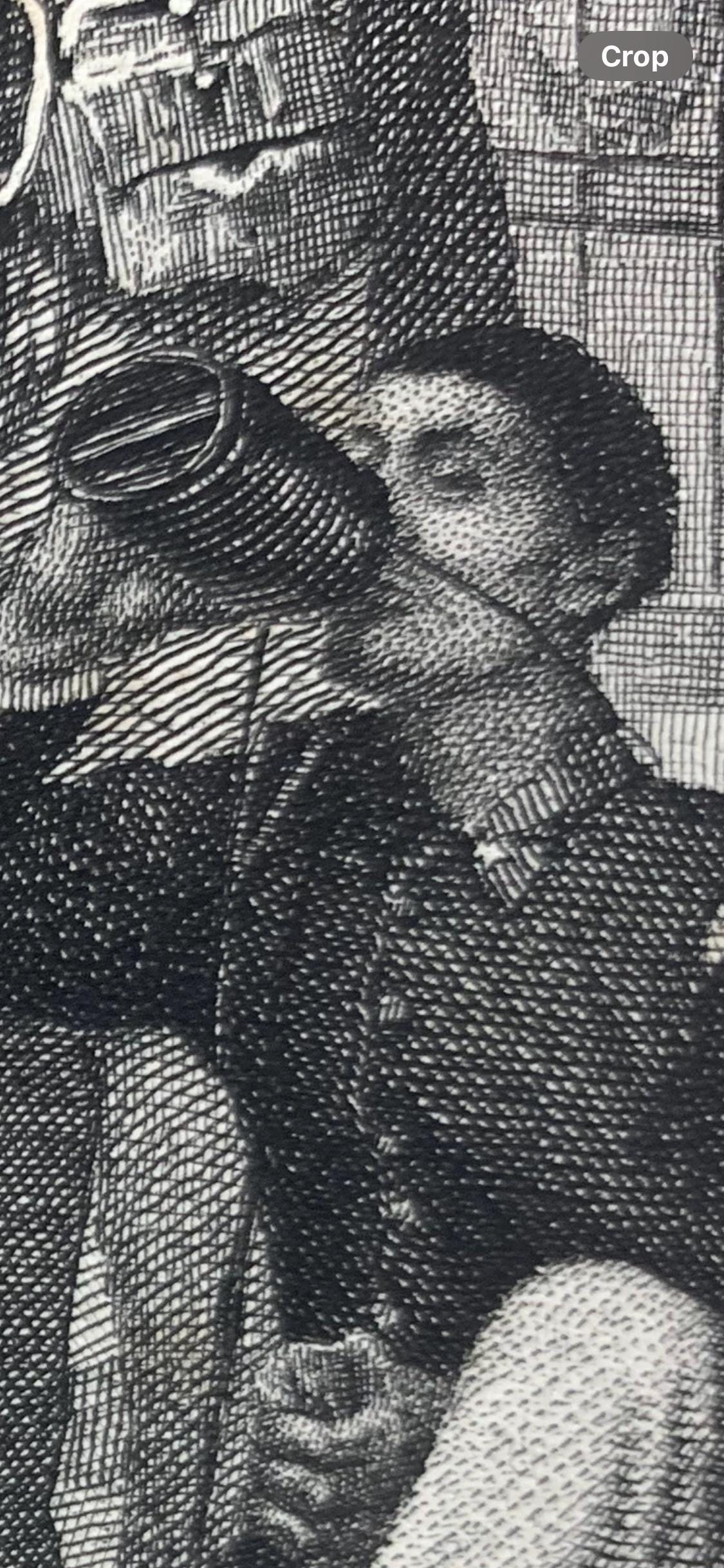
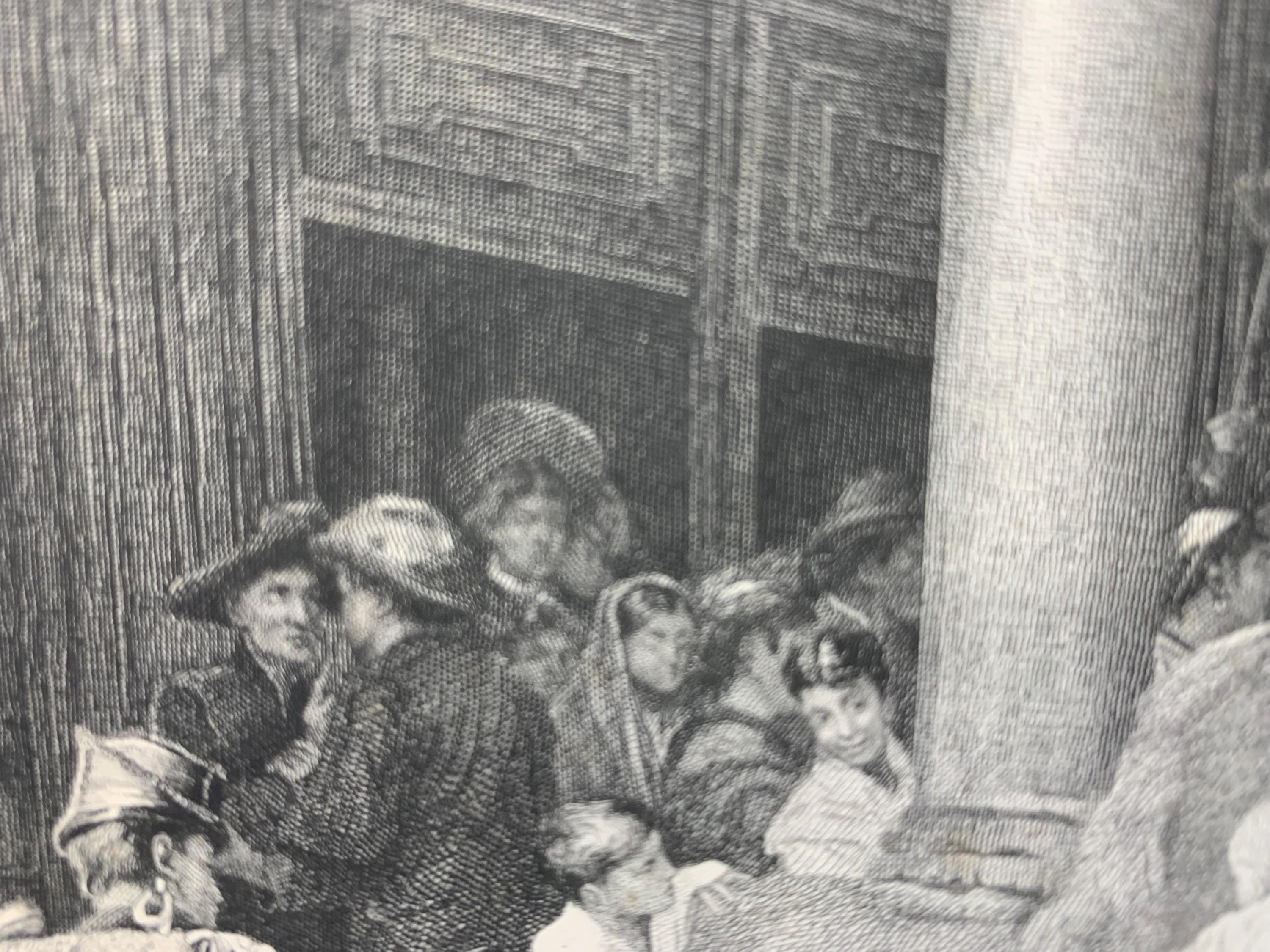

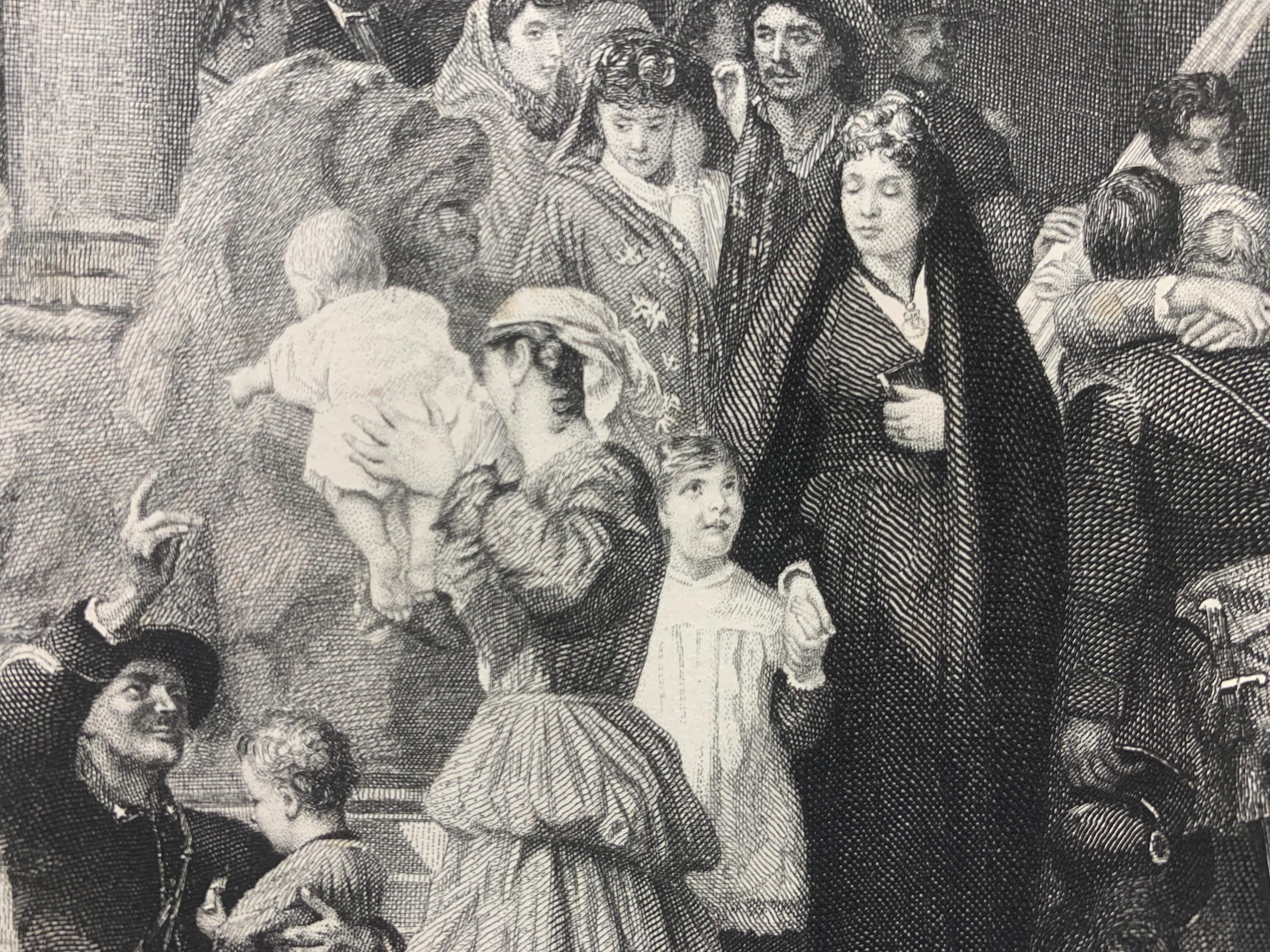
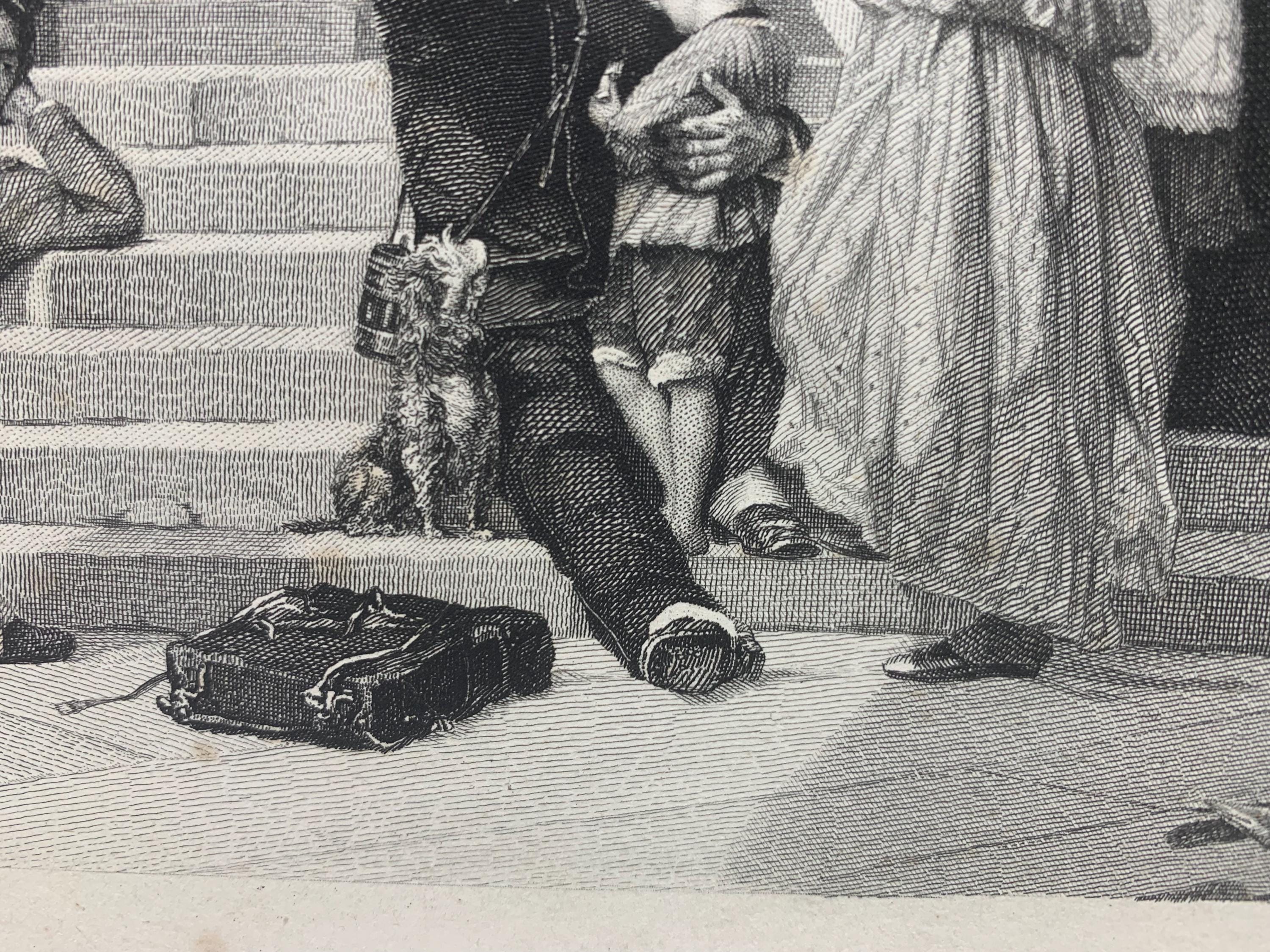



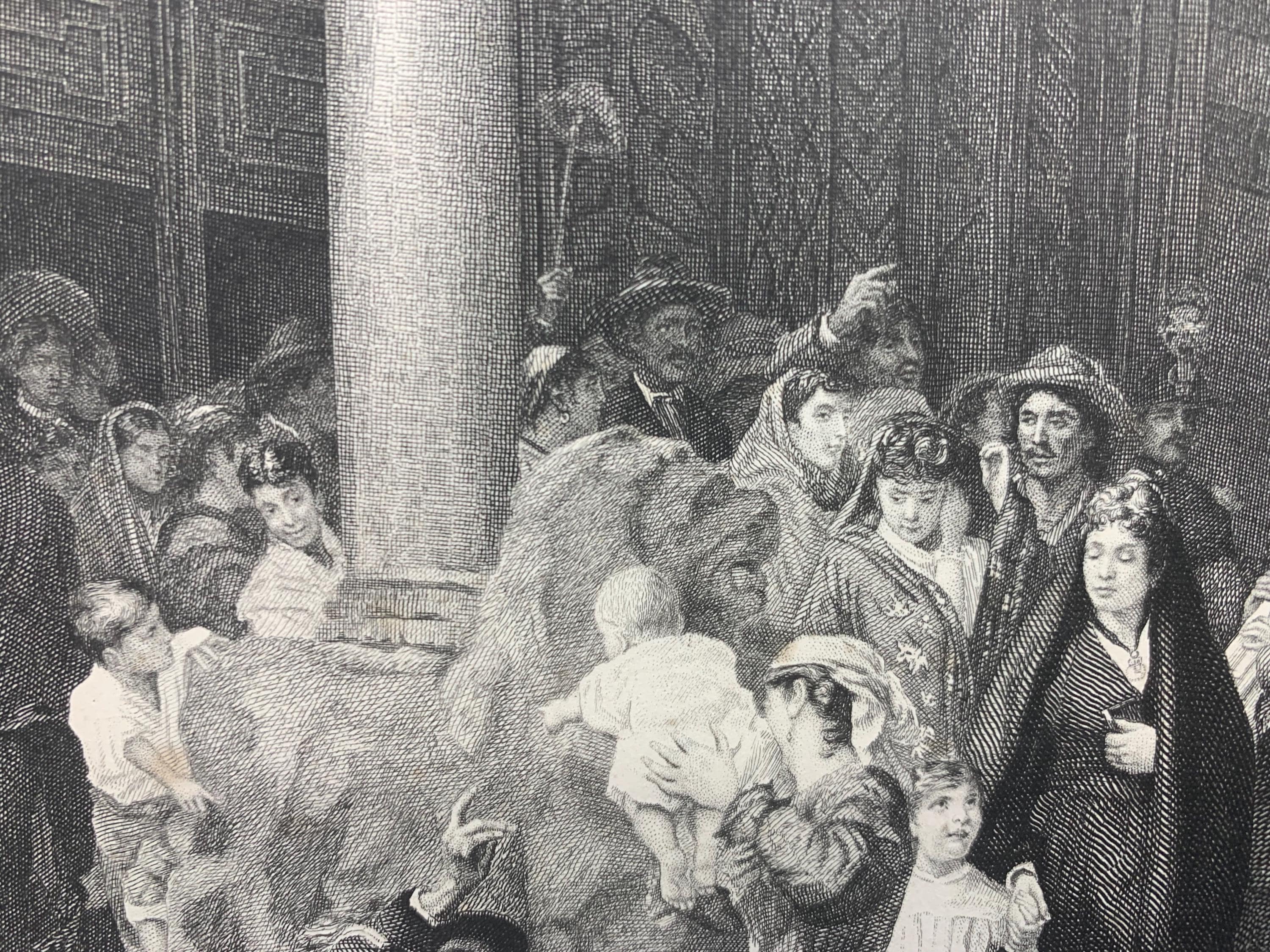
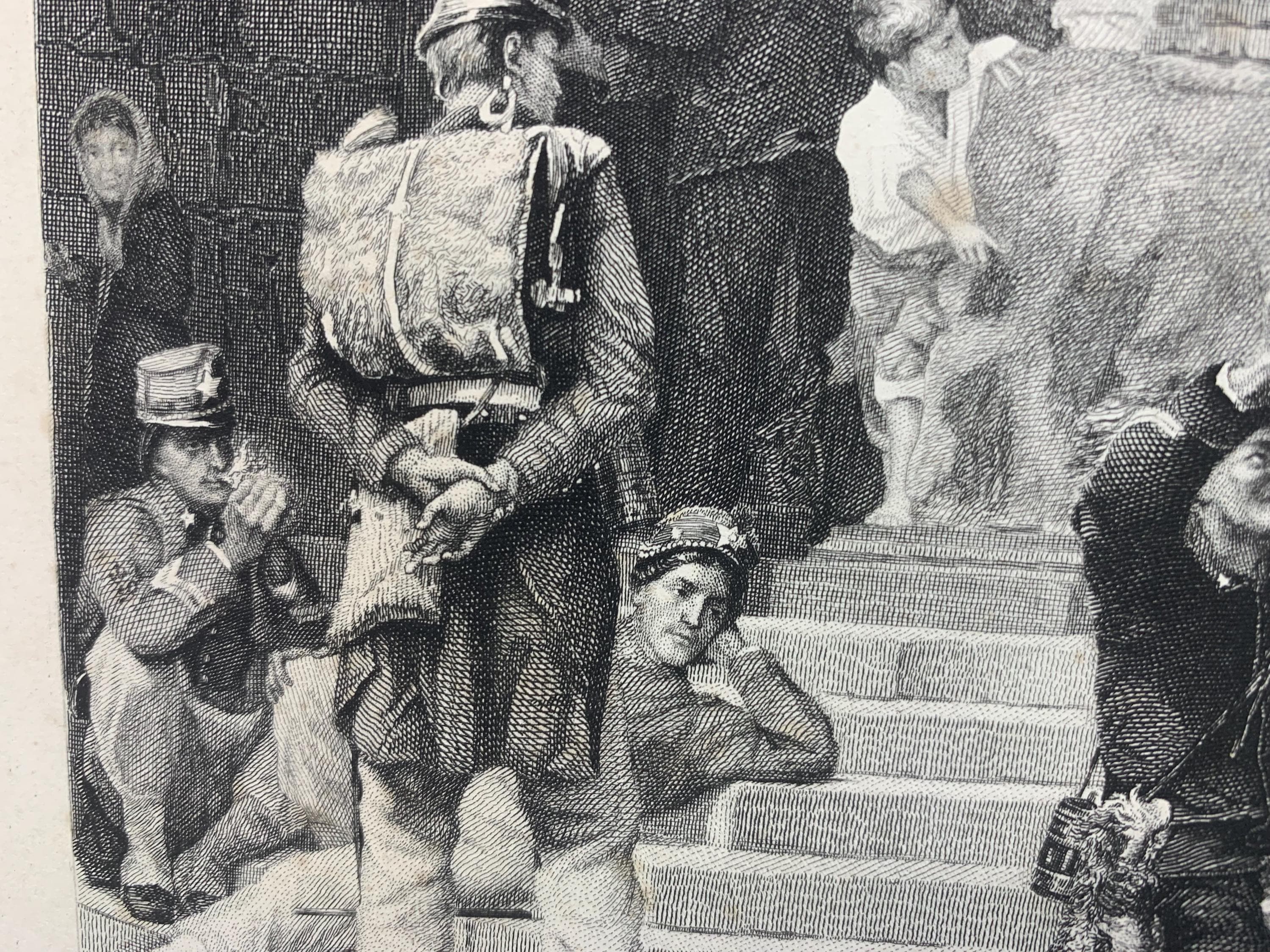
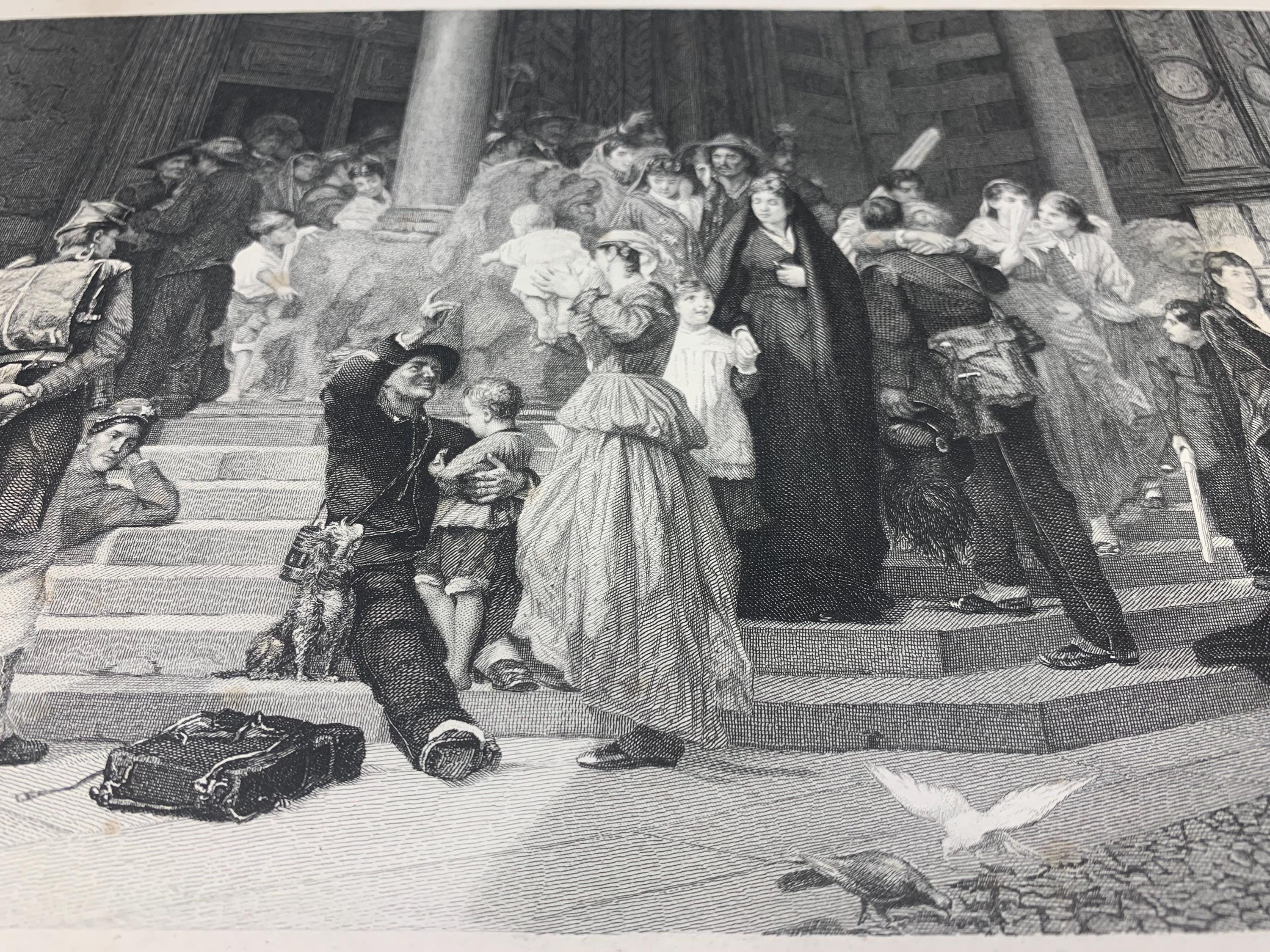
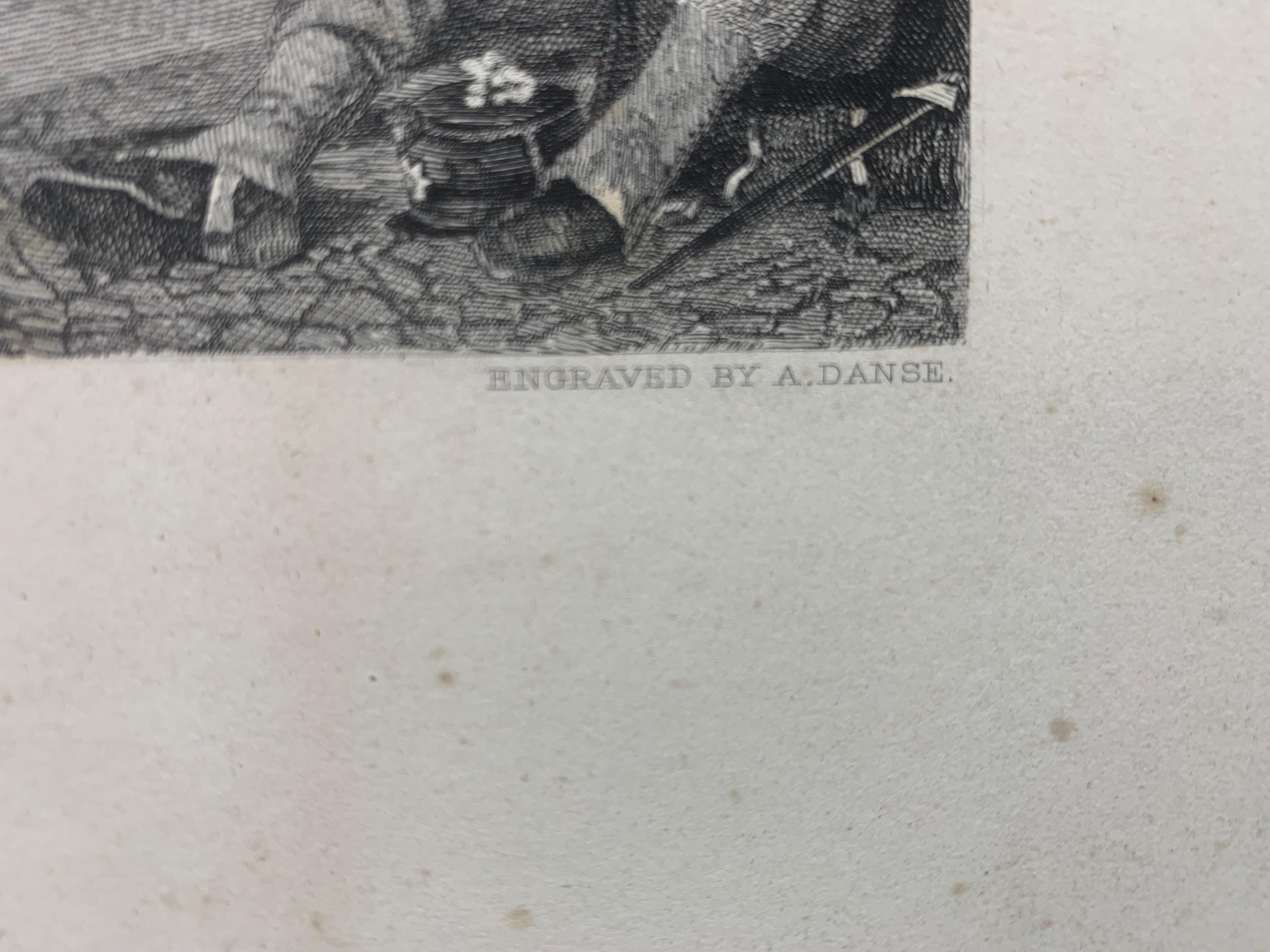
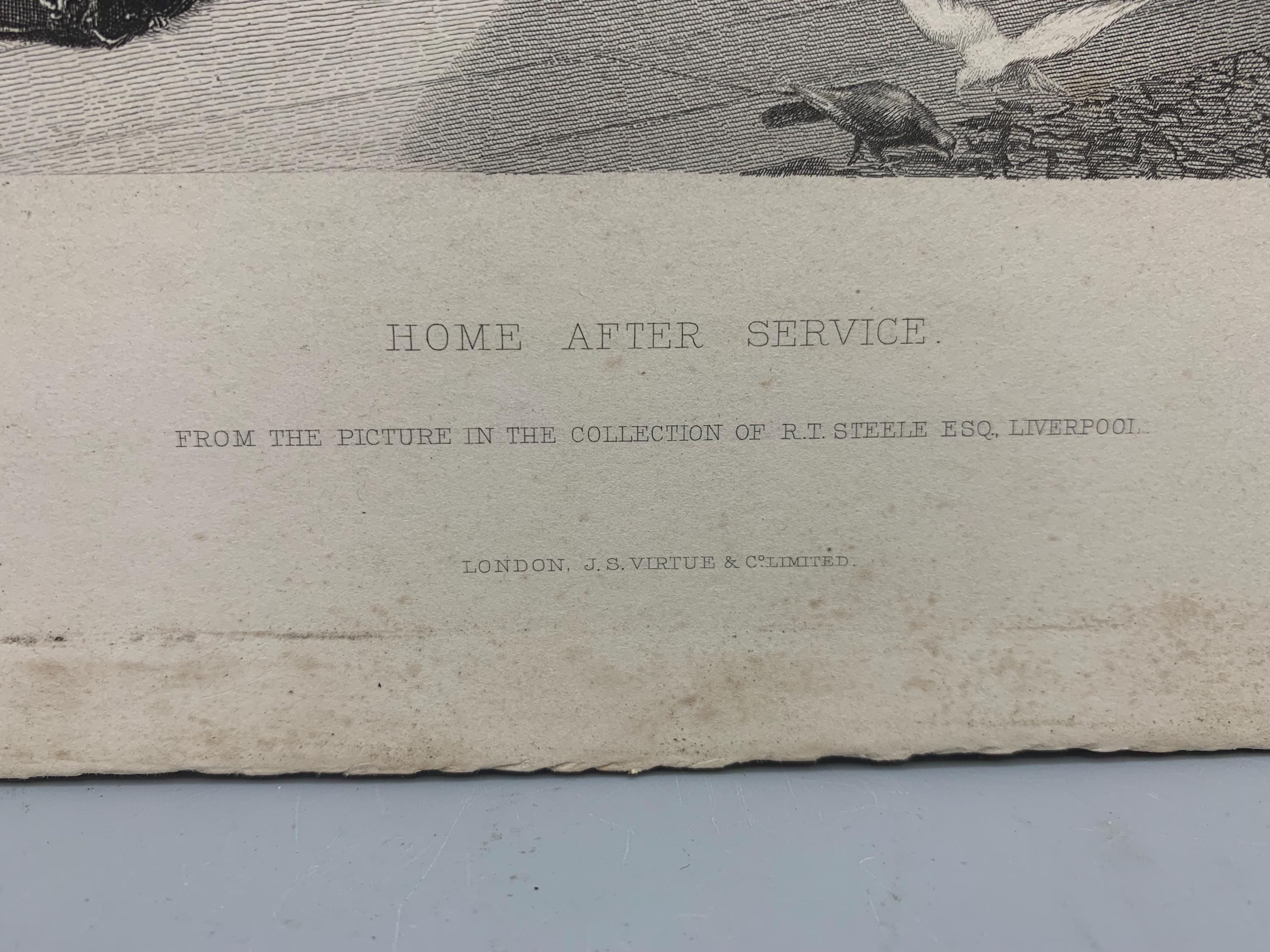

Antiques-100 Years Old +
Fine Art Engraving Plate Production-Britain, circa 1882
$100.00
-
DetailsORIGINAL ENGRAVED STEEL PLATE PRINT-
Steel engraving is a technique for printing
illustrations on paper using steel printing plates instead of copper, the harder metal allowing a much longer print run before the image quality deteriorates. It has been rarely used in artistic printmaking, although it was much used for reproductions in the 19th century. Steel "engraving", in fact technically mostly using etching, was introduced in 1792 by Jacob Perkins (1766–1849), an American inventor, for banknote printing. When Perkins moved to London in 1818, the technique was adapted in 1820 by Charles Warren and especially by Charles Heath (1785–1848) for Thomas Campbell's Pleasures of Hope, which contained the first published plates engraved on steel. The new technique only partially replaced the other commercial line engraving techniques of that time such as wood engraving, copper engraving and later lithography.
Confusingly, the printmaking technique used in steel engravings is, after the earliest years in the 1820s, normally a combination of etching and true engraving, with etching becoming dominant in later examples, after the technique became popular again in the 1830s. Engraving is done with a burin, which is a small bar of hardened steel with a sharp point. It is pushed along the plate to produce thin furrowed lines, leaving "burr" or strips of waste metal to the side. This is followed by the use of a scraper to remove any burs, since they would be an impediment during the subsequent inking process. Steel plates are very hard for this technique, which is normally used on softer copper plates. So steel engraving also used etching, where acid creates the lines in the plates in the pattern made by selectively removing a thin coating of acid-resistant ground by tools. This is much less effort. As well as etching needles, the etched part of steel engravings made great use of roulettes, small wheels mounted in handles which have regular sharp projections which produce broken lines of dots and dashes when rolled across the plate. Roulettes of different types were used together with the burin and needle to create densely packed marks which appear as tonal to the eye, and allow a great variety of textures and effects. True burin engraving was generally used to finish the etched image.
First a broad, general outline is made on the plate before starting the detailed image. Engraving will produce a printed reverse or mirror image of the image on the plate. Sometimes engravers looked at the object, usually another image such as a drawing, that they were engraving through a mirror so that the image was naturally reversed and they would be less likely to engrave the image incorrectly.
Steel plates can be case hardened to ensure that they can print thousands of times with little wear. The copper plates used in traditional engraving and etching, which are softer and so much easier to work cannot be case hardened but can be steel-faced or nickel-plated by electroplating to increase the number of impressions that could be printed. From about 1860 the steel-facing of copper plates became widely used, and such prints tend also to be called steel engravings. It can be very difficult to distinguish between engravings on steel and steel-faced copper, other than by date. The most reliable way of distinguishing between unfaced copper engraving and steel or steel-faced engraving is the "lightness and delicacy of the pale lines" in the latter. The hardness of the plate surface made it possible to print a good number of impressions without the metal of the plate wearing the lines out under the pressure of repeated intaglio printing, which would have happened with unfaced copper. So "A shimmering pale grey became for the first time a possibility in line engraving, and it is this that provides the most recognizable characteristic of steel beside the heavier and warmer mood of copper".
Until around 1820 copper plates were the common medium used for engraving. Copper, being a soft metal, was easy to carve or engrave and the plates could be used to strike a few hundred copies before the image began to severely deteriorate from wear. Engravers then reworked a worn plate by retracing the previous engraving to sharpen the image again. Another advantage to using copper is that it is a soft metal and can be corrected or updated with a reasonable amount of effort. For this reason, copper plates were the preferred medium of printing for mapmakers, who needed to alter their maps whenever land was newly discovered, claimed, or changed hands.
During the 1820s steel began to replace copper as the preferred medium of commercial publishers for illustration, but still rivaled by wood engraving and later lithography. Steel engraving produced plates with sharper, harder, more distinct lines. Also, the harder steel plates produced much longer wearing dies that could strike thousands of copies before they would need any repair or refurbishing engraving. The hardness of steel also allowed for much finer detail than would have been possible with copper, which would have quickly deteriorated under the resulting stress. As the nineteenth century began to close, devices such as the ruling machine made even greater detail possible, allowing for more exact parallel lines in very close proximity. Commercial etching techniques also gradually replaced steel engraving.
Steel engraving is still done today, but to a much lesser extent. Today, most printing is done using computerized stencils instead of a steel plate to transfer ink. An exception is currency, which is still printed using steel dies, since each bill then has a character and feel that is very difficult for counterfeiters to duplicate. An engraved plate causes the ink to be slightly raised and the paper to be slightly depressed, which produces a different haptic sensation than does paper printed by a stencil ink transfer process.
From the beginning of the nineteenth century, new tools made engraving much easier and more exact. The ruling machine created parallel straight or wavy lines very close together, usually for use with etching. Another of these tools is the geometric lathe. The lathe is used to engrave images on plates, which are in turn engraved on rolls for such uses as printing banknotes. Another of these tools is the engraving machine. This machine uses a master template to lightly engrave a duplicate image which can be then engraved by hand or etched with acid. The machine also makes possible the reduction or enlargement of the letter for the duplicate image. -from Wiki Wand (WW-ORMS)
*ABOUT THIS PRINT
Original Watercolor Artist:
Francis William Warwick Topham was born in London in 1838. He began studying art at an early age with his father, Francis W. Topham (1808-1877), one of England’s outstanding watercolor artists of the nineteenth century. He then studied at the Royal Academy Schools and at the Atelier Gleyre in Paris. He lived and painted in both Italy and France.
Topham enjoyed working with his father, and both men traveled to Ireland in 1860 to paint. They both visited Italy in 1863, particularly Rome and Capri. This was the first of several visits to Italy for the younger Topham. In 1865 he visited Ravenna with Egron Sellif Lungren (1815-1875) and Frank Dillon (1823-1909). Both Lundgren and Dillon were Orientalist painters, fascinated with North Africa. Topham, however remained devoted to Italy, a country which strongly influenced the course of his life’s work. From this period on, he began painting scenes of Italy, which were to remain his favorite subjects.
Topham began exhibiting at the Royal Academy in 1863, showing 60 works there over the course of his career. He also showed at the British Institution (4 works), Suffolk Street (4 works), New Watercolour Society (20 works), Grosvenor Gallery (14 works), New Gallery (14 works), Royal Society of Artists, Birmingham (36 works), Beaux Arts Gallery (2 works), Fine Art Society (1 work), Glasgow Institute of Fine Arts (8 works), Walker Art Gallery, Liverpool, (54 works), Manchester City Art Gallery (34 works), Royal Hibernian Academy (3 works), Society of British Artists, Royal Institute of Painters in Water Coulours, (77 works), Royal Institute of Oil Painters (130 works), Arthur Tooth and Sons (7 works) and Agnews and Sons Gallery (3 works).
His beautifully detailed genre and historical oils and watercolors were well received, and he was elected to the New Society of Watercolors in 1879 as well as the Royal Institute of Painters in Oils in 1883.
He lived for a time in London and then near Guildford in Surrey where he passed away on May 25, 1924. This production print is of Topham’s original painting entitled “Home After Service”.
The painting depicts Italian families gathering on the steps of Santa Maria Maggiore, Bergamo, to greet men who are returning home after military service. Topham painted the original for the private collection of wealthy ship owner and prominent maritime trader R.T. Steele of Liverpool in 1879. Steele’s watercolor original from Topham was sold in 1993 at Sotherby’s New York to a private collector.
The Engraver:
The engraver that etched Topham’s painting onto a steel plate was famous Belgian sculptor and engraver Auguste Danse or A. Danse. He etched the plate in 1881 at the art institute in Mons, Belgium.
His father, Mathieu-Joseph Danse, was a merchant. While still very young, he enrolled at the Royal Academy of Fine Arts, where he studied painting with François-Joseph Navez. He then studied engraving with Luigi Calamatta, who would be a major influence. After graduating, he was employed by Jacob Wiener and engraved medals. In 1851, he received a major commission from the Royal Academy of Science, Letters and Fine Arts to produce portraits for a series of biographies.
For many years, he earned his living from commercial work; designing stained glass windows and playing cards, and working in a textile factory, engraving the copper printing cylinders. He lost the latter position when the American Civil War made cotton difficult to obtain. From that point on, he devoted himself entirely to engraving; producing copies of the old Dutch Masters.
In 1871, he became a drawing teacher at the art academy in Mons. He retained that position until his retirement in 1897, and helped create an engraving school there in 1882. At the Exposition Universelle (1889) and the Exposition Universelle (1900), he was awarded silver medals.
Beginning in the early twentieth-century, his attention turned more to painting; primarily maritime scenes and landscapes. In 1903, he produced a series of portraits for the Belgian royal family. Two years later, he became a member of the Royal Academy. He remained active until 1911. Retrospectives of his work were held that year and in 1920.
He died shortly after his hundredth birthday. A street in Uccle was named after him. The Royal Library of Belgium has a collection of his original engravings. His notable students included Paul Craps and Elisabeth Wesmael. His wife, Adèle, was the sister of Jean-Baptiste Meunier (1821–1900), a graphic artist. Their daughters, Marie and Louise, both became engravers. Marie would marry the controversial politician, Jules Destrée.- from Wikipedia
The Printing Press in London:
J.S. Virtue & Co. Ltd. was a prominent London book and print publishing firm founded by George Virtue in the 1820s, with James Sprent Virtue taking over the business in 1855. The firm is known for publishing illustrated books and becoming a major player in the art and print industry, especially after acquiring and rebranding The Art Union as The Art Journal. It also established other businesses and partnerships, and its influence grew through its various publications and offices across North America.
Founder George Virtue (1794–1868) first built the firm's headquarters at Ivy Lane, Paternoster Row, London.
In 1848, George Virtue acquired The Art Union, a British art magazine, and renamed it "The Art Journal" in 1849. He also partnered with Arthur Hall to create the firm "Arthur Hall, Virtue & Co." that same year.
George Virtue established a larger printing works at 294 City Road, London, to handle printing, engraving, and binding in-house. James Sprent Virtue took over his father's business in 1855. He initiated the series of prints based on national art collections, such as the Royal, Sheepshanks, and Turner collections, which were popular with subscribers. In 1862, J.S. Virtue and his brother George Henry Virtue organized a new business called Virtue Brothers & Company at 1 Amen Corner. The firm published other well-known works, including illustrated editions of the Holy Bible and Tomlinson's Cyclopedia of Useful Arts. In 1865, his brother William Alexander Virtue joined the company as a partner.
After George Henry's death in 1866, J.S. Virtue sold some of his business holdings.
William Alexander Virtue then moved to the United States to manage the American branch of the company until his death in 1875. J.S. Virtue & Co. Ltd continued to publish and print until 1911 and then was absolved in 1914 when Britain entered WWII.
Materials:
Durable woven paper made from cotton and linen rags. The dye used was oil-based printing ink. The binding medium, or vehicle, of this ink was typically a linseed oil varnish, and the primary colorant for black ink was a finely ground carbon pigment, such as lampblack or ivory black.
Not framed, permanently pasted on 1970s art board and condition is great. Some oxidations on paper but otherwise the illustration is excellent.
MemoryLaneVintiques purchased this item from a private collector that lived in Flower Mound, Texas.
Size of production print:
Width 10-3/8 inches (26.3 cm)
Height 6-5/8 inches (16.8) cm)
Size on Board:
Width 14-1/2 inches
Height 11-1/4 inches
MemoryLaneVintiques would like to thank Grace Higgins Brown of Wellcome Collection in London, England for their assistance with identifying and sharing the details needed for our bio-listing for this item;
Grace Higgins Brown
Wellcome Collection
183 Euston, Rd
London,NW1 2BE
* The Wellcome Collection is a free museum and library in London that explores the connections between medicine, life, and art. It
houses a vast collection of historical medical artifacts, artworks, and books amassed by Sir Henry Wellcome. The venue offers changing exhibitions, public events, a café, and a bookshop to challenge public understanding of health and human experience.
MemoryLaneVintiques sanitizes all glassware, jewelry, resin made, wooden and glazed pottery before packing for shipment....100% Guaranteed!
ETSY INTELLECTUAL PROPERTY POLICY
As a venue for artists, designers, and makers, Etsy takes intellectual property rights very seriously. We comply with intellectual property laws and industry best practices in order to maintain the integrity of our creative marketplace. This Intellectual Property Policy explains how we address allegations of infringement, how authorized parties can submit reports of infringement regarding content on our marketplace, and how Etsy sellers can respond when their listings or shops are affected by a report.
ANY COPY AND PASTING OR PLAGIARIZING OF MATERIAL
ON MEMORYLANEVINTIQUES IS SUBJECT TO ETSY INVESTIGATION AND PENALTIES!
MemoryLaneVintiques researches also protect our shop from Intellectual Property Theft by researching for violators of our material. Be respectful!
Chad & Jennifer Johnston (August 2024)
MemoryLaneVintiques uses artificial lighting in the photos of items.
